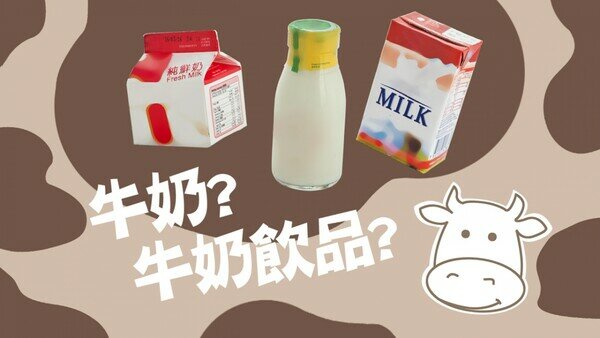"Milk" is considered as a healthy drink. How much do we know about it though? The Consumer Council collected and examined the product descriptions on the packaging of 22 milk and 18 milk beverage samples available in the market. It is found that, on 8 milk beverage samples, the font size of "drinks/beverage" is printed smaller than that of "milk". Consumers might easily confuse it with milk.
Among 40 samples of this study, only 9 samples label the production date on their packages. In addition, most of the 23 pasteurised milk or milk beverage samples did not clearly state in their labels the specific pasteurisation method applied, i.e. whether by "traditional pasteurisation" or "extended shelf life ultra-pasteurisation" (ESL).
The Council believes that the trade should not only state the expiry date but also clearly label the production date and specific method of heat treatment applied on their packaging. This will enable consumers to understand more about product freshness and enhance product information transparency.
Milk products available in the market could be broadly divided into "milk" and "milk beverage". The Council noticed that on some "milk beverage" packages, the word "milk" is more prominently printed in larger fonts than "drinks/beverage", which could lead the consumers into believing that the products are "milk". By comparing merely on prices, consumers could hardly differentiate "milk" from "milk beverages". Consumers are advised to read product and nutrition labels before making their choices.
Milk and milk beverages sold in the market have to undergo heat treatment to kill bacteria. "Pasteurisation" or "sterilisation" are the two methods most commonly applied.
"Pasteurisation" can kill most of the bacteria but cannot deactivate spores. Therefore, pasteurised products still contain a small amount of bacteria, it must be refrigerated at or below 4°C.
Pasteurisation is further divided into "traditional pasteurisation" and "extended shelf life ultra-pasteurisation" (ESL). With a shelf life of 2 to 3 weeks, product undergone traditional pasteurisation has a relatively lower impact on nutrition and taste. ESL product has a shelf life of 30 to 90 days and is mainly used by imported milk products. As ESL applies higher temperature during the heat treatment, some water-soluble vitamins are lost in the process.
"Sterilisation" uses higher temperature that kills most bacteria and deactivates spores in milk product. The treatment process can be further divided into "ultra-high temperature processing" (UHT) and "in container sterilisation". In UHT, a treatment process commonly seen in Hong Kong, milk products are heated to a temperature of not less than 132°C and retaining it at not less than that temperature for at least 1 second; while the "in container sterilisation" method heats the content to and retained at a temperature of not less than 100°C for not less than 25 minutes in the containers.
Unopened products of most sterilised milk or milk beverages would usually enjoy a shelf life of 6 to 9 months in room temperature. The flavour, texture and taste of milk may change under sterilisation treatment with relatively higher temperature. Coupled with the heat treatments under both methods, long storage period may increase the loss of water-soluble vitamins. The loss rate of water-soluble vitamins in UHT-processed milk products usually falls between 10% and 15%, while the average loss rate of "in container sterilised" milk products is approximately 40%.
Different heat treatment methods have various impacts on shelf life, storage and taste of milk and milk beverages. Among the 23 "milk" or "milk beverage" samples pasteurised, only 2 clearly labelled that "high temperature short time method" (HTST) of "traditional pasteurisation" method applied. It is noted that the German Dairy Association has rolled out an agreement of voluntary labelling of heat treatment which helps consumers differentiate the two pasteurisation methods of milk products. The Council recommends the local diary industry to follow this good practice. However, Hong Kong has yet to introduce a regulation on specifying how ESL should be processed and labelled on dairy product packaging.
Consumers should pay attention to the following when purchasing milk products:
- Brand name may not be directly related to the product origin. The colour of package may not be related to the type of milk it contains. Consumers should not choose milk products simply base on brand perception and their impression;
- In general, pasteurised products were subjected to lower heat during treatment process, hence their taste and nutrition level were less affected with shelf life shorter than UHT processed products. They are more likely to be recently produced. Some water-soluble vitamins in the milk and milk beverages may be loss as a result of ESL or sterilisation treatment. Nevertheless this will not affect the nutritional status of healthy children and adults who maintain a balanced diet;
- Check whether the package of milk or milk beverages is intact, their expiry dates, and store them according to the instruction on the labels. Once opened, the products should be consumed as soon as possible, and repated refrigeration should be avioded;
- Choose on the basis of personal needs, for instance adults and the elderly may choose products with lower fat and higher calcium content; while people with special needs should consult their doctors or dietitians.
The Consumer Council reserves all its right (including copyright) in respect of CHOICE magazine and Online CHOICE.



